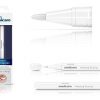
You may have heard the term, ‘buffering anesthetic’ in relation to dentistry or even medicine wondered about it or know a little and want to know more. Either way, we here at Aesthetic Family Dentistry are more than happy to help.
Buffering anesthetic is a term used to describe a technique we use to make anesthetic injections less uncomfortable. Even if you don’t mind needles, the scrape or sting of the needle going in sets some people’s teeth on edge. Some don’t like it at all. Which is where buffering anesthetic comes in.
Buffering anesthetic
Buffering anesthetic refers to the lowering of the pH level of the anesthetic to make it less painful. Off the shelf anesthetics are quite acidic and won’t actually work properly until the pH level has been lowered by the soft tissue in your mouth. This is why sometimes we need more than one injection to completely numb an area of the mouth.
This acidity also contributes to that sting felt during the injection itself, which buffering anesthetic seeks to reduce by neutralizing the pH level. It is also believed that reducing the pH level of anesthetic makes it much more effective.
So why can’t big pharma give us neutral pH anesthetic? Apparently it is chemically impossible to create a long-lasting neutral pH anesthetic. The acid is needed to preserve the drug otherwise it would have a shelf life of only a couple of days which would render is almost useless. So we are currently limited by chemistry, which is why techniques such as buffering is necessary.
A buffered anesthetic is one where some kind of pH lowering element is added before we use the vial. Usually a bicarbonate of some kind designed specifically for this purpose, it is added to the anesthetic prior to use to make it more effective and more comfortable to introduce into the system.
You may have heard the term, ‘buffering anesthetic’ in relation to dentistry or even medicine wondered about it or know a little and want to know more. Either way, we here at Aesthetic Family Dentistry are more than happy to help.
Buffering anesthetic is a term used to describe a technique we use to make anesthetic injections less uncomfortable. Even if you don’t mind needles, the scrape or sting of the needle going in sets some people’s teeth on edge. Some don’t like it at all. Which is where buffering anesthetic comes in.
Buffering anesthetic
Buffering anesthetic refers to the lowering of the pH level of the anesthetic to make it less painful. Off the shelf anesthetics are quite acidic and won’t actually work properly until the pH level has been lowered by the soft tissue in your mouth. This is why sometimes we need more than one injection to completely numb an area of the mouth.
This acidity also contributes to that sting felt during the injection itself, which buffering anesthetic seeks to reduce by neutralizing the pH level. It is also believed that reducing the pH level of anesthetic makes it much more effective.
So why can’t big pharma give us neutral pH anesthetic? Apparently it is chemically impossible to create a long-lasting neutral pH anesthetic. The acid is needed to preserve the drug otherwise it would have a shelf life of only a couple of days which would render is almost useless. So we are currently limited by chemistry, which is why techniques such as buffering is necessary.
A buffered anesthetic is one where some kind of pH lowering element is added before we use the vial. Usually a bicarbonate of some kind designed specifically for this purpose, it is added to the anesthetic prior to use to make it more effective and more comfortable to introduce into the system.
This is only made possible by a specialist piece of equipment that allows us to add a bicarbonate to a vial of anesthetic without compromising its effectiveness or sterility. The equipment measures a very precise amount of buffering agent and adds it to the vial of anesthetic. With this equipment, we can prepare anesthetic before we administer it while keeping everything perfect safe.
The benefits of buffering anesthetic
As mentioned, part of the sting of an anesthetic injection is the acidity of the contents. By lowering the pH and reducing that acidity, much of the sting is taken away. We also believe that anesthetic works faster and much more effectively when buffered to a more neutral pH.
That means we need to use less drugs to achieve the same goal and that the drug works much more effectively. As holistic dentists, this is a considerable benefit because we want to introduce as few chemicals as possible into your body. Plus, anything that lowers discomfort is good news for everyone!
Looking for a better numbing experince in Denville NJ? Contact Aesthetic Family Dentistry today!This is only made possible by a specialist piece of equipment that allows us to add a bicarbonate to a vial of anesthetic without compromising its effectiveness or sterility. The equipment measures a very precise amount of buffering agent and adds it to the vial of anesthetic. With this equipment, we can prepare anesthetic before we administer it while keeping everything perfect safe.
The benefits of buffering anesthetic
As mentioned, part of the sting of an anesthetic injection is the acidity of the contents. By lowering the pH and reducing that acidity, much of the sting is taken away. We also believe that anesthetic works faster and much more effectively when buffered to a more neutral pH.
That means we need to use less drugs to achieve the same goal and that the drug works much more effectively. As holistic dentists, this is a considerable benefit because we want to introduce as few chemicals as possible into your body. Plus, anything that lowers discomfort is good news for everyone!
Looking for a better numbing experince in Denville NJ? Contact Aesthetic Family Dentistry today!









